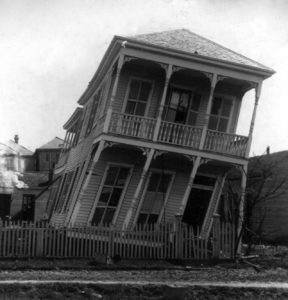Hurricane Harvey has left Texas. Hurricane Irma will soon make landfall in Florida. Hurricane Jose is in the Atlantic Ocean, following Irma. Hurricane Katia is in the Gulf of Mexico, poised to strike Mexico. Given all these hurricanes, it’s easy to feel fed up with nonstop hurricane news coverage.
To be sure, there is much to cover, between casualties, property damage, rebuilding, and everything else. But tomorrow also marks a dubious anniversary for Texans and hurricane watchers—namely, the 117th anniversary of the 1900 Great Storm that devastated Galveston.
Both the 1900 storm, which didn’t have a name as we name them today, and Harvey were Category 4 storms. A Category 4 storm means winds were between 130-156 mph. Both storms hit at night. One key difference is that Harvey focused on Port Aransas and Rockport, which lie southwest of Galveston.
In terms of casualties, the 1900 storm was much worse. Thousands of people—estimates are between 6,000 and 8,000, with some at about 12,000—died. Harvey, by contrast, has caused fewer than 100 casualties.
Property damage from Harvey is worse. The catastrophe modeling firm AIR Worldwide estimated that property losses from Harvey would be between $65-75 billion. Property damage from the 1900 storm was about $21 million (in 1900 money), which today would be $516,887,081. Among that property damage was approximately 3,600 homes destroyed. Much of the island was underwater, with debris from destroyed buildings being washed out to sea. It led to the construction of the seawall to guard against storm surge when future hurricanes hit Galveson.
Part of the reason why people were ready for a storm like Harvey is because of the advanced communication systems in use today. The 1900 storm passed over Cuba, yet Cuban authorities did not tell the Texas authorities what was coming. Moreover, when the storm hit Galveston, the people in Houston didn’t yet realize how serious the situation was until the next day.
Today, of course, between the satellite images and weather radar shown on television and the Internet, cell phones, social media, and the like, nobody could be surprised.
Nobody wants to go through a hurricane, but with today’s technology giving us advance warnings, we’re in a better position to save lives and property.

